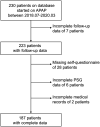Predictors for short-term and long-term automatic PAP compliance
- PMID: 35962941
- PMCID: PMC9806787
- DOI: 10.5664/jcsm.10236
Predictors for short-term and long-term automatic PAP compliance
Abstract
Study objectives: Positive airway pressure (PAP) is considered a standard treatment for obstructive sleep apnea (OSA), but there are compliance issues. As compliance to PAP tends to decrease with time, it is necessary to consider reasons affecting compliance at each period. Therefore, this study aimed to define factors affecting short-term and long-term compliance to PAP therapy.
Methods: One hundred eighty-seven patients with OSA who started PAP treatment between July 2018 to March 2020 were included. Acceptance and compliance rates were monitored. Demographics, polysomnography (PSG) profiles, cephalometric data, and physical examination results were analyzed to identify factors predictive of PAP compliance at short-term (3 months) and long-term (12 months) periods.
Results: The acceptance rate of PAP was 92.5%. Compliance at 3 months and 12 months was 79.1% and 51.3%, respectively. Higher apnea-hypopnea index (odds ratio [OR] 1.018, P = .049) and older age (OR 1.032, P = .039) were predictive factors of good automatic PAP (APAP) compliance at 3 months. However, long-term compliance was affected by the percentage of duration with O2 desaturation of < 90% (CT90; OR 1.032, P = .011) and baseline self-reported symptom scores such as nasal obstruction (OR 0.819, P = .038) and awakening (OR 0.796, P = .045).
Conclusions: In PAP use, indicators of OSA severity such as apnea-hypopnea index affect short-term compliance. On the other hand, the mandibular plane to hyoid distance and self-reported symptoms such as nasal obstruction and awakening can affect long-term compliance.
Citation: Park SI, Kim BK, Lee KE, Hong SD, Jung YG, Kim HY. Predictors for short-term and long-term automatic PAP compliance. J Clin Sleep Med. 2023;19(1):17-26.
Keywords: obstructive sleep apnea; patient compliance; positive airway pressure.
© 2023 American Academy of Sleep Medicine.
Conflict of interest statement
All authors have seen and approved the manuscript. Work for this study was performed at Samsung Medical Center. This study was funded by the SMC-Ottogi Research Fund (#SMX1162161) and a National Research Foundation of Korea (NRF) grant funded by the Korean government (MEST; 2017R1A2B4006453). The funder had no role in the study design, data collection, analysis, decision to publish, or preparation of the manuscript. The authors report no conflicts of interest.
Figures



Comment in
-
Factors influencing automatic PAP compliance: what really matters?J Clin Sleep Med. 2023 Jan 1;19(1):1-2. doi: 10.5664/jcsm.10356. J Clin Sleep Med. 2023. PMID: 36377841 Free PMC article. No abstract available.
References
-
- Nieto FJ , Young TB , Lind BK , et al . Association of sleep-disordered breathing, sleep apnea, and hypertension in a large community-based study. Sleep Heart Health Study . JAMA. 2000. ; 283 ( 14 ): 1829 – 1836 . - PubMed
Publication types
MeSH terms
LinkOut - more resources
Full Text Sources
Research Materials

